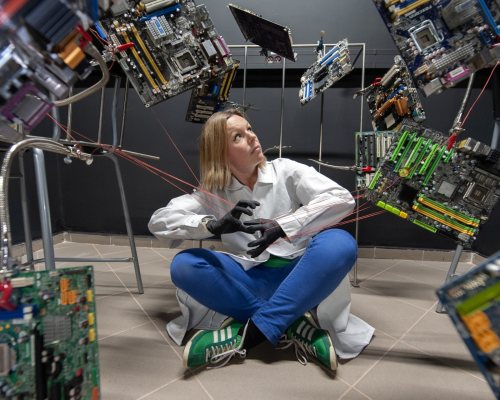Push the piston and measure
Reading time: about 8 minuts

The intensive development of new technologies, especially in the field related to the construction of new portable devices used as sensors for the detection of many chemical compounds has brought many surprising solutions. One of them is an electronic tongue that can answer various questions about unknown samples: presence and amount of some specific compound, contamination, spoilage, or providing seemingly unmeasurable information such as taste. Such devices, however, would not have succeeded without the development of efficient, fast and inexpensive sensors, such as electrochemical sensors. Recent paper published by the researchers from the Institute of Physical Chemistry, Polish Academy of Sciences led by dr. Emilia Witkowska Nery demonstrates the low-cost, ion-selective syringe electrodes to be used to quantify potassium level in a wide range of food products, and pharmaceutical supplements. Let’s take a look closer on this research.
One of the most important elements right after carbon, oxygen, nitrogen, and sulfur in the human body is potassium. This element is responsible for regulation of the pH in cells, the reactivity of muscles, such as the heart muscle regulating blood pumping in the circulatory system, and the transmission of electrical impulses in the nerves being inextricably linked to the work of the nervous system. Proper potassium levels are not only about adequate blood pressure, but also about ensuring proper electrolyte balance and kidney function. Disruption of potassium levels in the body can lead to the serious health consequences including, for example, nerve necrosis interfering with depolarization of heart cells, which can lead to changes in heart rhythm, such as bradycardia. Therefore, quick and simple determination of potassium levels in biological samples is important for quick and effective diagnosis. The same also matters for monitoring a wide variety of biologically important elements in ionic form in samples.
In the latest work, researchers at the Institute of Physical Chemistry of the Polish Academy of Sciences (IPC PAS) led by the dr. Emilia Witkowska Nery have presented a quantitative, low-cost electrode array for determining potassium levels in food and pharmaceuticals, which is a step forward in precise, fast and accurate potassium levels in biological fluids. However, prevention is better than cure by consuming adequate potassium levels through a balanced diet. In a healthy body, a healthy spirit, and ensuring adequate potassium levels in food is of paramount importance to maintaining health. Hence, let's take a look at studies of potassium levels in food samples, which researchers from the IPC PAS recently described in a scientific article.
They presented a novel system for determining potassium levels in liquid food samples, including juices and mineral supplements, using a fast and non-destructive technique that operates over a high dynamic range compared to commercially available devices but without troublesome recalibration. Their work highlighted the low-costs of analysis and the development of techniques that could be selective and easily adapted to the analysis of different samples. All this is to make point-of-care devices available in the near future.
Why do we need sensors and where did the idea for such research come from? A sensor is a device used to detect the concentration of substances in various media, mainly liquid, such as blood, urine, saliva, water, etc. One of the most important features of sensors is their selectivity, which is the ability to respond to only the chemical species of interest in the presence of other species. Response of a sensor is a resultant of the signal from the species that we want to detect, but also interfering species, temperature etc. That is why sensors are calibrated for specific type of sample. A sensor in a home glucometer is prepared to provide accurate glucose readings in blood from a finger prick. We can use it to measure glucose content in saliva or even in food products but the readings will not be accurate, simply because the sensor wasn’t calibrated for different pH and interfering species from those other samples. In today's world full of health threats, we need sensors in every field, from diagnostic sensors for determining a patient's health status or diagnostics, to sensors for the presence and level of certain chemical compounds in a given sample such as in food samples. Often it would be advantageous to use the same sensor for different types of samples.
To achieve their goal, and show that sensors can be used to directly measure species of interest in different samples the researchers used commonly known and widely used for years ion-selective electrodes based on the valinomycin ionophore. Valinomycin is a recognition molecule used in sensors that offers high selectivity for potassium binding. Disposable syringes were used to create the sensors, used as an alternative to classic, expensive sensor bodies, providing not only high efficiency and precision due to the use of a selective ionophore, but also reducing the cost of potassium level analysis. The low-cost syringe sensors were characterized by excellent selectivity and linear range.
"We describe a new, simple way to construct ion-selective electrodes with internal conditioning solution. Electrodes can be easily made from readily available materials, such as disposable syringe bodies. Comparison of main analytical parameters with standard ISE electrodes prepared using commercial bodies showed proper functioning of the syringe sensors. Reproducibility of the sensors was further confirmed by the analysis of PCA Loadings and a correlation matrix.” – remarks dr. Emilia Witkowska-Nery – the head of this project.
However, as was expected for this kind of sensors although the results showed remarkably high precision, the accuracy of the assay was below acceptable limit for samples with more complex compositions and higher ionic strengths such as beet soup, dried fruit and tomato products. Sensors would need to be calibrated for each type of sample in order to provide an accurate reading.
In order to improve the accuracy of the conducted measurement without the need for additional calibration for each new sample type an array of sensors was prepared. Different variations of the sensors in the array were tested in which the syringed played the key role. In addition to the physical performance of the electrodes, a suitable algorithm had to be optimized to take advantage of the information from different electrodes in media with complex chemical compositions. To determine the potassium concentration in real samples, various methods were used, ranging from partial least squares (PLS), multivariate linear regression (MLR), principal component regression (PCR) and the Random Forest (RF) algorithm, where RF is an ensemble method in which multiple decision trees are combined for a single result. Researchers also tested if it would be possible to substitute the best, but expensive valinomycin ionophore by a much cheaper but also not so selective corona ether.
Elżbieta Jarosińska - the main researcher in this project add “Compared to a quantification of potassium using a standard calibration curve, the root mean square error of prediction was almost six times lower. We have also shown how the array can be designed to achieve comparable analytical performance using less selective ionophores, such as dibenzo-18-crown-6 instead of valinomycin.”
Tests were prepared for real samples such as mineral water, tomato juice, banana juice, dried dates, tomato sauce, beet soup concentrate and pharmaceutical potassium supplements. The performance of the proposed syringe-based system and the proposed valinomycin substitute shows extremely high effectiveness in the determination of potassium content in many complex samples containing other ions and organic substances that can affect detection. The proposed methodology can be used in biomedical diagnostics as well to enhance the accuracy of measurement when using commercial sensors. Do you remember your last blood or urine exam? Was only one parameter measured? We often measure multiple parameters, not only cholesterol but HDL, LDL, triglycerides and often many more. Without any change in the measurement but just in the calibration procedure such tests could be much more accurate by using the methodology developed by Dr. Witkowska-Nery’s group. Beside staying curious while doing research, scientists working on the aforementioned project emphasize the importance of the simplifying the path to achieve the goal. Creating diagnostic points accessible to everyone these days requires simplicity of the methods used and low cost of testing. And it is these factors that the authors of this study focus on.
This research published in the Electrochimica Acta was supported by the National Science
Center Sonata 2020/39/D/ST4/02256 project.
CONTACT:
Dr. Emilia Witkowska Nery
Institute of Physical Chemistry, Polish Academy of Sciences
Phone: +48 22 343 3306
e-mail: ewitkowskanery@ichf.edu.pl
ARTICLE:
“Low-cost, syringe based ion-selective electrodes for the evaluation of potassium in food products and pharmaceuticals”
Elżbieta Jarosińska, Julia Wojnowska, Martyna Durka, Marta Podrażka, Emilia Witkowska Nery
Volume 508, 2024, 145209
https://doi.org/10.1016/j.electacta.2024.145209
- Author: Dr Magdalena Osial
- Contact: magdalena@osial.eu
- Photo source: Grzegorz Krzyżewski
- Date: 9.01.2025







